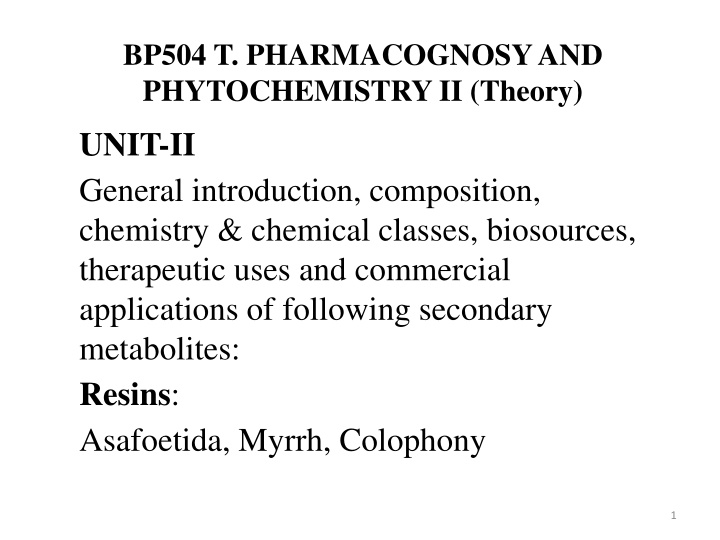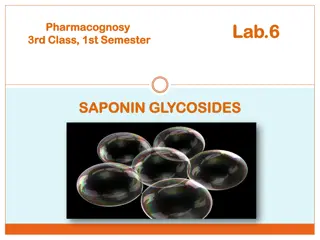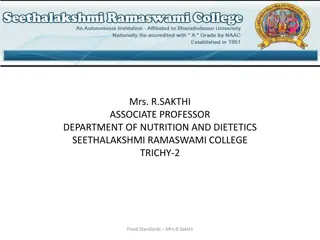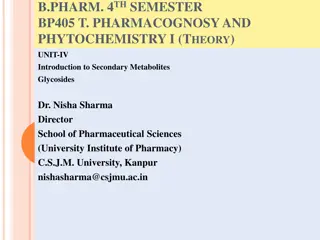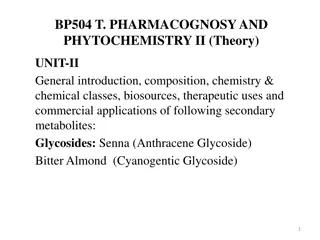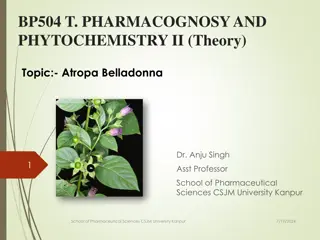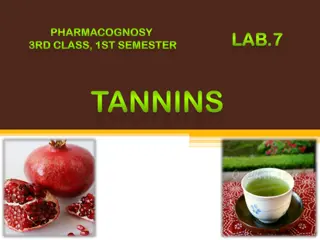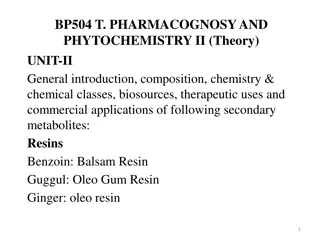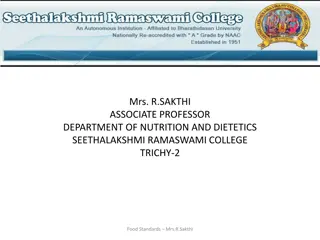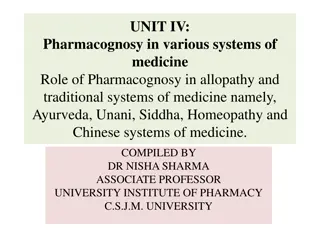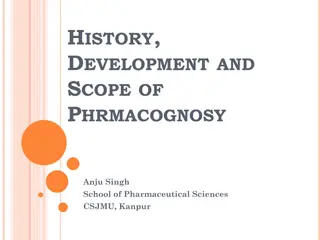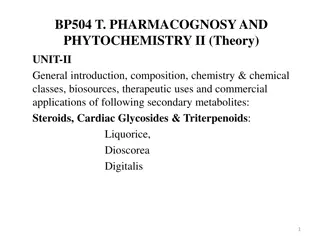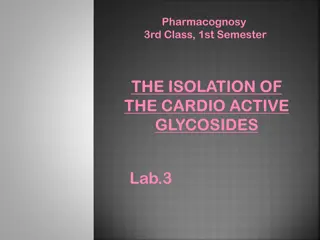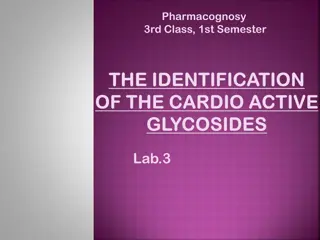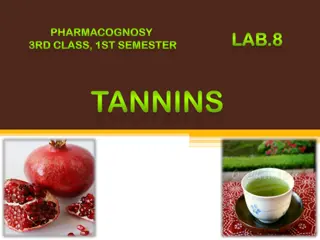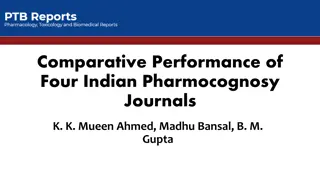Asafoetida: Composition, Collection, and Uses in Pharmacognosy
Asafoetida, also known as Gum Asafoetida or Devil's dung, is an oleo-gum resin obtained from Ferula species. It contains trans-ferulic acids and is harvested by incising the roots. The resin is collected, dried, and prepared for commercial use. Asafoetida has a distinct color, odor, and taste, and its chemical composition includes resin, gum, and volatile oil. It is valued for its therapeutic properties and is commonly used in traditional medicine.
Download Presentation

Please find below an Image/Link to download the presentation.
The content on the website is provided AS IS for your information and personal use only. It may not be sold, licensed, or shared on other websites without obtaining consent from the author.If you encounter any issues during the download, it is possible that the publisher has removed the file from their server.
You are allowed to download the files provided on this website for personal or commercial use, subject to the condition that they are used lawfully. All files are the property of their respective owners.
The content on the website is provided AS IS for your information and personal use only. It may not be sold, licensed, or shared on other websites without obtaining consent from the author.
E N D
Presentation Transcript
BP504 T. PHARMACOGNOSY AND PHYTOCHEMISTRY II (Theory) UNIT-II General introduction, composition, chemistry & chemical classes, biosources, therapeutic uses and commercial applications of following secondary metabolites: Resins: Asafoetida, Myrrh, Colophony 1
Asafoetida Asafoetida, Gum Asafoetida, Devil's dung B S: Oleo-gum resin obtained by incision from the rhizomes & roots of Ferula foetida, Ferula rubricaulis & other species of Ferula, family Umbelliferae. contains not less than 0.10 % of Trans Ferulic acids calculated on dry basis. G S: Perennial herb, Mediterranean region to Central Asia, Iran, Afghanistan. 03 species of Ferula found in India. Ferula narthex in Kashmir. 3
Asafoetida Collection and Preparation for the Market: In Afghanistan, resin is obtained from carrot shaped massive roots & rhizomes of the plants of about 4 - 5 yrs age & 12-15 cm in diameter. In the month of March-April, just before the flowering season of the plant, the upper part of the roots, very close to the crown, is cut off. The milky juice oozes out of the cut surface & starts coagulating. This cut surface is covered by the dome-shaped device made up of leaves & the branches to avoid the contamination with sand and foreign organic matter. 4
Asafoetida to avoid the contamination with sand and foreign organic matter. After few days, the coagulated matter is scrapped off & the fresh cuts are given to collect more exudate. This is continued for about three months or until the plants cease to produce latex. On average, plant yields about 1 kg of the oleo-gum resin. After collection, it is dried thoroughly and packed in suitable containers. 5
Asafoetida Description Color - Yellowish-white changing to reddish-brown Odor - Intense, persistent, penetrating & alliaceous Taste - Bitter, alliaceous & acid Size - tears 0.5-3 cm in dia. Shape - occurs in 2 different forms i.e. tears & masses. Tears- rounded or flattened. Extra Features: Fresh tears-tough but when dried become hard & brittle. Tears- internally milky whitish-yellow, translucent or opaque. Mass of asafoetida is agglutinated & mixed with root fragment, foreign material & other impurities. 6
Asafoetida Chem C: Contains resin (40-65%t), gum (20-25%), & volatile oil (4-20%). The resin chiefly consists of asaresinotannol in the free or combined form with ferulic acid. Free umbelliferone is absent (distinction from galbanum). Ferulic acid on treatment with HCl gets converted into umbellic acid, which upon loosing water forms umbelliferone. 7
Asafoetida Oil of asafoetida: obtained by steam distillation of the oleo-gum resin. The chief constituents of the oil are secondary butyl propanyl disulphide. Other constituents are di and trisulphides, pinene & other terpenes. The specific odor of the drug is due to sulphur compounds of the formulae C7 H14 S2, C16H20S2 and C10H18S2. OCH3 HO HO OH O HO CHCO CH CH CHCOOH Umbellic acid CH CHCOOH Umbelliferone Ferulic acid 8
Asafoetida Identification 1. Fractured surface of the drug, + H2SO4 red/reddish- brown color. 2. Drug + 50% HNO3 gives green color 3. Drug + triturate with water forms yellowish-orange emulsion 4. Drug 0.5g + Triturate with sand + 5 ml of HCl + add little qty of water filter filtrate + add eq volume of NH3 blue fluorescence due to presence of umbelliferone. Galbanum, an oleo-gum resin obtained from Ferula galbaniflua, is an allied drug to asafoetida. Galbanum contains free umbelliferone. 9
Asafoetida Uses: as carminative, nervine stimulant, or in intestinal flatulence, as flavouring agent for curries, sauces and pickles and in veterinary medicine. Adulterants : Asafoetida is adulterated with gum arabic, rosin, gypsum, red clay, chalk and barley or wheat flour. 10
Colophony 11
Colophony Rosin; Rosina, Colophonium; Resin; Amber-resin, Gum rosin, pine-resin. B S: It is the residue left after the distillation of the oil of turpentine from the crude-oleoresin obtained from various species of Pinus, family Pinaceae. G S: Prepared in North America, Northern Europe, Pakistan, India. Description: Color: Pale yellow to yellowish brown or amber color. Odor & Taste: Faint, terebinthinate. Size: in the form of angular, translucent masses of various sizes. 12
Colophony Extra Features: Brittle & readily fusible, glossy appearance. Solubility: insoluble in water, soluble in alcohol, CS2, CHCl3, ether, many fixed & volatile oils, gl CH3COOH, light petroleum. C C: mainly resin acids which are unsaturated & hence reactive. About 90% of this is abietic acid. The composition of the drug varies according to the source & storage conditions etc. The drug also contains esters of oleic acid & resin acids. It also contains 0.5% volatile oil; 5 to 6% resenes. 13
Colophony Other acids in the colophony are sapinic acid & pimaric acid. Unsaponifiable matter of colophony, which constitutes about 3 - 10 % contains hydrocarbons & high molecular weight alcohols. 14
Colophony Identification: 1. Colophony 1g + dissolve in 10 ml of acetic anhydride by gentle heat + drop of H2SO4 bright red color to violet 2. Alcoholic solution of colophony is acidic to litmus. 3. Dissolve colophony in light petroleum ether & double the volume with dil. solution of copper acetate, petroleum layer takes emerald green color (due to the copper salt of abietic acid). 15
Colophony Uses: a stimulant & diuretic It is ingredient of certain plaster masses & collodions (syrupy sol. nitrocellulose in ether & alcohol, used as surgical dressing) It is also used in the preparation of ointments. Rapin-esters are used as protective coatings like polymers. Industrially, used in preparation of varnishes, insulating compounds, soaps, printing inks, paper sizing in preparation of floorings, soldering compounds, mastics & pressure sensitive's adhesives. 16
Colophony Storage : should be stored in the ungrounded condition in well filled, well closed containers away from light & in cool places. In the powder form- gets oxidized quickly & looses its solubility in light petroleum & gets increased in the weight & hence, it should be stored properly. Adulterants: adulterated with black resin or apic resin. However, both of them can be confirmed by solubility. 17
Myrrh Gum Myrrh, Bol, Myrrha B S: It is an oleo-gum-resin obtained from Commiphora molmol & from other Commiphora species. family Burseraceae. G S: In North East Africa & Southern Arabia 18
Myrrh Collection and Preparation for the Market: One of the characteristics of family Burseraceae is the plants possess oleo-resinous canals in their conducting tissues. The plants are small shrubs or trees about 3 m in height. The plants exude yellowish-colored resin when the incisions are made in bark of tree. It gradually hardens & becomes dark or reddish- brown in color. This coagulated mass is collected in goat skins by the native tribals & sent to the market. 19
Myrrh Description: Color-Externally-reddish-brown, internally- brown. Odor & Taste Aromatic & agreeable. Size-About 1.5 to 3.0 cm in diameter. Shape- found in the form of rounded or irregular tears. Extra Features: Fractured surface of the drug is somewhat granular. It is brittle & shows translucent surface Whitish spots on broken pieces are also seen. 20
Myrrh Identification 1. substance 0.1 g + 0.5 g sand + triturated with solvent ether filtered allowed to evaporate thin film formed gives violet color on contact with bromine vapors. 2. substance + triturated with water yellowish-brown emulsion. Uses: As stimulant, antiseptic, protective. It is astringent to mucous membrane, hence tincture is used in mouth washes & gargles. 21
Myrrh Adulteration : Substituted by several species like Arabian myrrh, Yemen myrrh, etc. Both are less fragrant & less aromatic. In India, myrrh is substituted by Balsam odendron mukul, known as Indian bdellium. 22
Myrrh Chem C: contains about 10% yellowish thick volatile oil; 60% gum; 25to 40% resin, & bitter principle (about 3 to 4%). Contains several impurities constituting about 5% of the drug. Resin contains ether-soluble resin acids, , & commiphoric acids. The & heerabomyrrholic acids are ether-insoluble acids present in resin. The volatile oil contains terpenes, cuminic aldehyde, eugenol, etc. The gum is associated with oxidase enzyme. It yields not more than 70 % of alcohol-insolube matter. 23
References Pharmacognosy, C.K. Kokate, A.P. Purohit, S.B. Gokhale, 54th Ed. 2017, Nirali Publication, New Delhi 24
